Analysis of Vicarious Liability in OHS Law: Employer Responsibilities
VerifiedAdded on 2023/06/07
|9
|2658
|53
Report
AI Summary
This report examines the concept of vicarious liability within the context of occupational health and safety (OHS) law, specifically analyzing the case of Vinod, a delivery driver for Yum Yum Pizzas, and the resulting accident involving Penelope. The report first establishes the legal distinction between an employee and an independent contractor, applying tests such as the control test, integration test, and multiple tests to determine Vinod's employment status. The analysis concludes that Vinod is an employee, and therefore, Yum Yum Pizzas bears vicarious liability for his actions while in the course of his employment, even though he made a detour. The report then addresses Penelope's injuries, considering the principles of contributory negligence and comparative negligence, concluding that Penelope is entitled to compensation from Yum Yum Pizzas, but the amount is reduced based on her contribution to the accident due to her intoxication. The report underscores the importance of understanding the legal implications of employer-employee relationships, especially regarding compensation and negligence in workplace incidents.
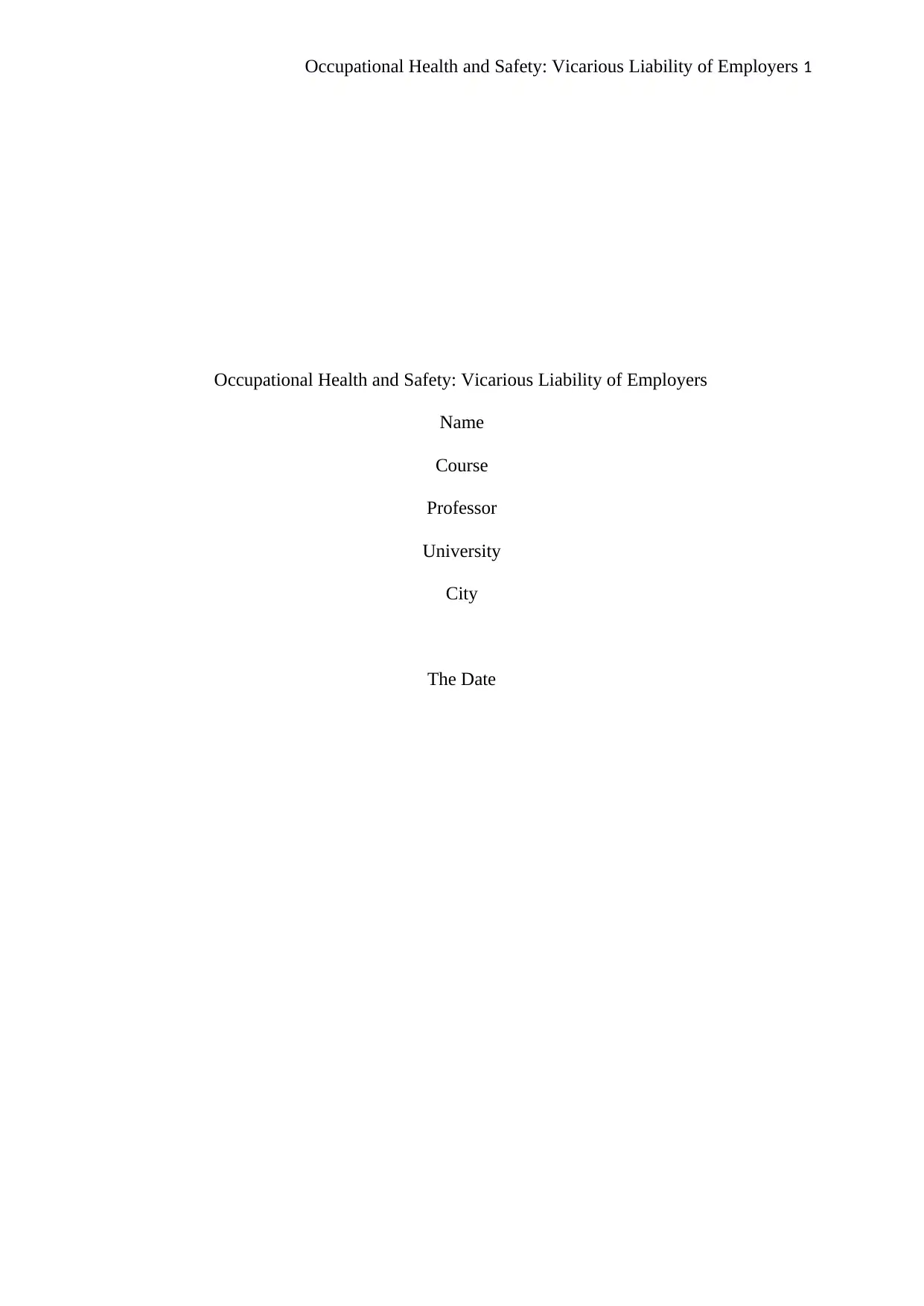
Occupational Health and Safety: Vicarious Liability of Employers 1
Occupational Health and Safety: Vicarious Liability of Employers
Name
Course
Professor
University
City
The Date
Occupational Health and Safety: Vicarious Liability of Employers
Name
Course
Professor
University
City
The Date
Paraphrase This Document
Need a fresh take? Get an instant paraphrase of this document with our AI Paraphraser
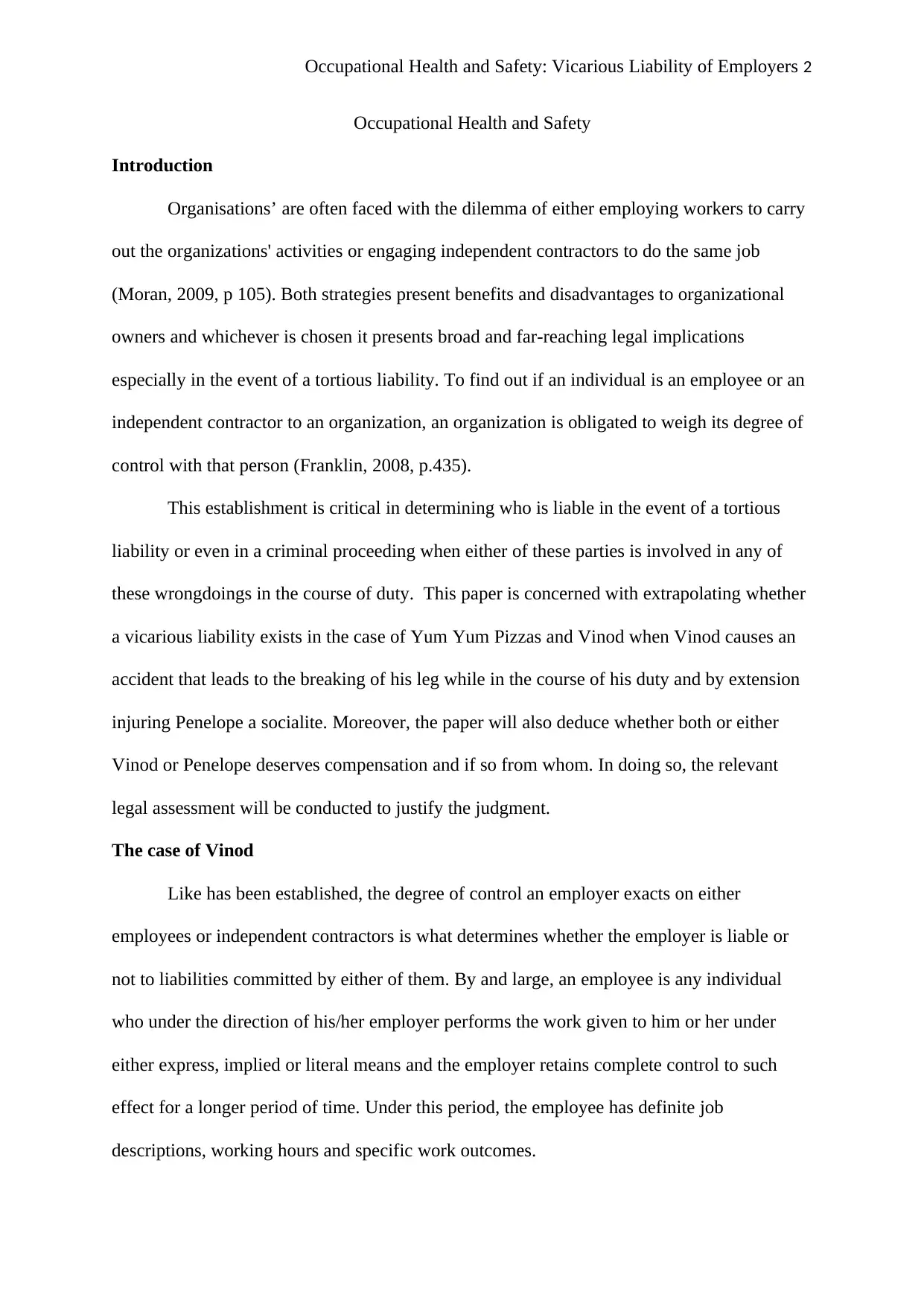
Occupational Health and Safety: Vicarious Liability of Employers 2
Occupational Health and Safety
Introduction
Organisations’ are often faced with the dilemma of either employing workers to carry
out the organizations' activities or engaging independent contractors to do the same job
(Moran, 2009, p 105). Both strategies present benefits and disadvantages to organizational
owners and whichever is chosen it presents broad and far-reaching legal implications
especially in the event of a tortious liability. To find out if an individual is an employee or an
independent contractor to an organization, an organization is obligated to weigh its degree of
control with that person (Franklin, 2008, p.435).
This establishment is critical in determining who is liable in the event of a tortious
liability or even in a criminal proceeding when either of these parties is involved in any of
these wrongdoings in the course of duty. This paper is concerned with extrapolating whether
a vicarious liability exists in the case of Yum Yum Pizzas and Vinod when Vinod causes an
accident that leads to the breaking of his leg while in the course of his duty and by extension
injuring Penelope a socialite. Moreover, the paper will also deduce whether both or either
Vinod or Penelope deserves compensation and if so from whom. In doing so, the relevant
legal assessment will be conducted to justify the judgment.
The case of Vinod
Like has been established, the degree of control an employer exacts on either
employees or independent contractors is what determines whether the employer is liable or
not to liabilities committed by either of them. By and large, an employee is any individual
who under the direction of his/her employer performs the work given to him or her under
either express, implied or literal means and the employer retains complete control to such
effect for a longer period of time. Under this period, the employee has definite job
descriptions, working hours and specific work outcomes.
Occupational Health and Safety
Introduction
Organisations’ are often faced with the dilemma of either employing workers to carry
out the organizations' activities or engaging independent contractors to do the same job
(Moran, 2009, p 105). Both strategies present benefits and disadvantages to organizational
owners and whichever is chosen it presents broad and far-reaching legal implications
especially in the event of a tortious liability. To find out if an individual is an employee or an
independent contractor to an organization, an organization is obligated to weigh its degree of
control with that person (Franklin, 2008, p.435).
This establishment is critical in determining who is liable in the event of a tortious
liability or even in a criminal proceeding when either of these parties is involved in any of
these wrongdoings in the course of duty. This paper is concerned with extrapolating whether
a vicarious liability exists in the case of Yum Yum Pizzas and Vinod when Vinod causes an
accident that leads to the breaking of his leg while in the course of his duty and by extension
injuring Penelope a socialite. Moreover, the paper will also deduce whether both or either
Vinod or Penelope deserves compensation and if so from whom. In doing so, the relevant
legal assessment will be conducted to justify the judgment.
The case of Vinod
Like has been established, the degree of control an employer exacts on either
employees or independent contractors is what determines whether the employer is liable or
not to liabilities committed by either of them. By and large, an employee is any individual
who under the direction of his/her employer performs the work given to him or her under
either express, implied or literal means and the employer retains complete control to such
effect for a longer period of time. Under this period, the employee has definite job
descriptions, working hours and specific work outcomes.
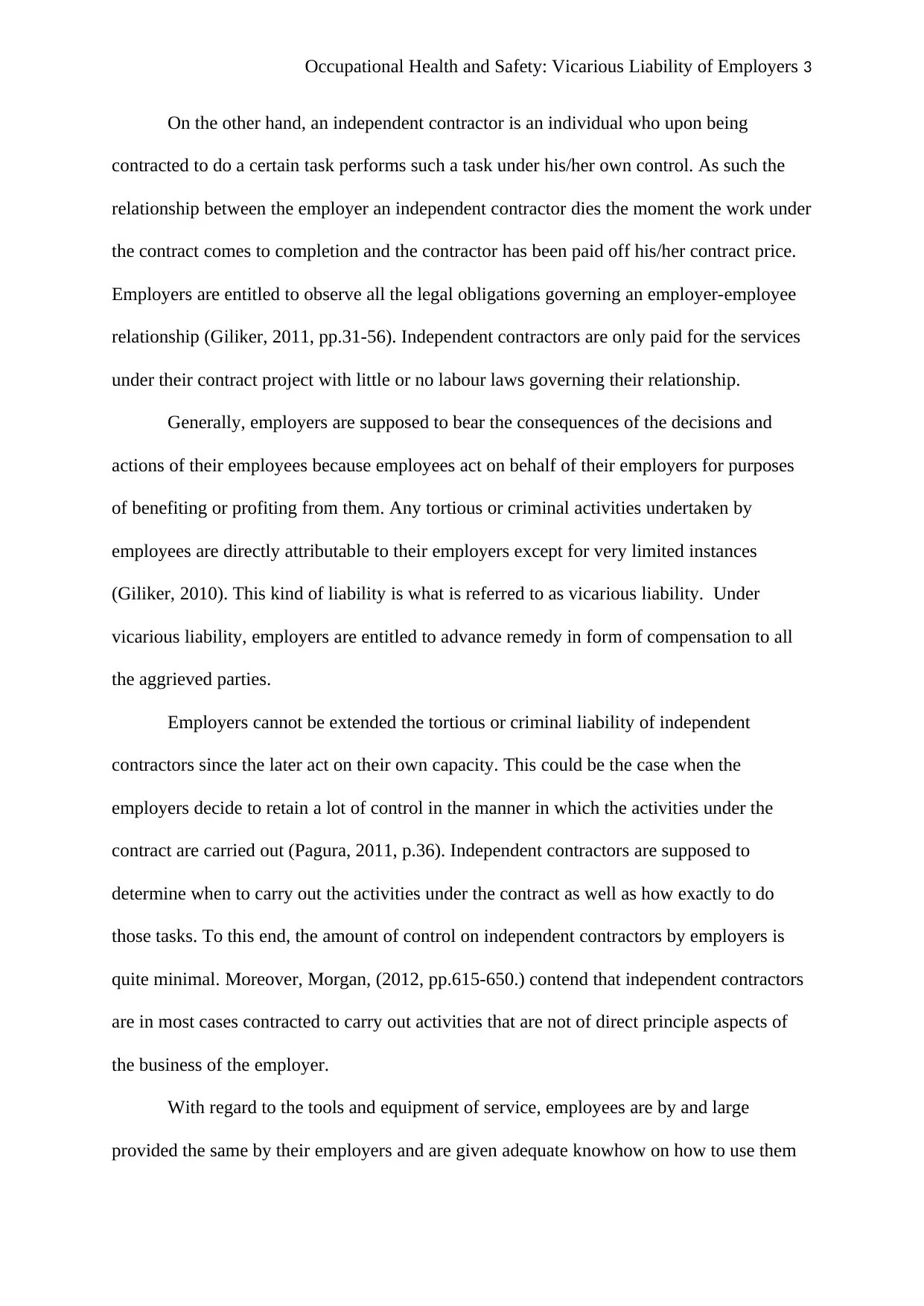
Occupational Health and Safety: Vicarious Liability of Employers 3
On the other hand, an independent contractor is an individual who upon being
contracted to do a certain task performs such a task under his/her own control. As such the
relationship between the employer an independent contractor dies the moment the work under
the contract comes to completion and the contractor has been paid off his/her contract price.
Employers are entitled to observe all the legal obligations governing an employer-employee
relationship (Giliker, 2011, pp.31-56). Independent contractors are only paid for the services
under their contract project with little or no labour laws governing their relationship.
Generally, employers are supposed to bear the consequences of the decisions and
actions of their employees because employees act on behalf of their employers for purposes
of benefiting or profiting from them. Any tortious or criminal activities undertaken by
employees are directly attributable to their employers except for very limited instances
(Giliker, 2010). This kind of liability is what is referred to as vicarious liability. Under
vicarious liability, employers are entitled to advance remedy in form of compensation to all
the aggrieved parties.
Employers cannot be extended the tortious or criminal liability of independent
contractors since the later act on their own capacity. This could be the case when the
employers decide to retain a lot of control in the manner in which the activities under the
contract are carried out (Pagura, 2011, p.36). Independent contractors are supposed to
determine when to carry out the activities under the contract as well as how exactly to do
those tasks. To this end, the amount of control on independent contractors by employers is
quite minimal. Moreover, Morgan, (2012, pp.615-650.) contend that independent contractors
are in most cases contracted to carry out activities that are not of direct principle aspects of
the business of the employer.
With regard to the tools and equipment of service, employees are by and large
provided the same by their employers and are given adequate knowhow on how to use them
On the other hand, an independent contractor is an individual who upon being
contracted to do a certain task performs such a task under his/her own control. As such the
relationship between the employer an independent contractor dies the moment the work under
the contract comes to completion and the contractor has been paid off his/her contract price.
Employers are entitled to observe all the legal obligations governing an employer-employee
relationship (Giliker, 2011, pp.31-56). Independent contractors are only paid for the services
under their contract project with little or no labour laws governing their relationship.
Generally, employers are supposed to bear the consequences of the decisions and
actions of their employees because employees act on behalf of their employers for purposes
of benefiting or profiting from them. Any tortious or criminal activities undertaken by
employees are directly attributable to their employers except for very limited instances
(Giliker, 2010). This kind of liability is what is referred to as vicarious liability. Under
vicarious liability, employers are entitled to advance remedy in form of compensation to all
the aggrieved parties.
Employers cannot be extended the tortious or criminal liability of independent
contractors since the later act on their own capacity. This could be the case when the
employers decide to retain a lot of control in the manner in which the activities under the
contract are carried out (Pagura, 2011, p.36). Independent contractors are supposed to
determine when to carry out the activities under the contract as well as how exactly to do
those tasks. To this end, the amount of control on independent contractors by employers is
quite minimal. Moreover, Morgan, (2012, pp.615-650.) contend that independent contractors
are in most cases contracted to carry out activities that are not of direct principle aspects of
the business of the employer.
With regard to the tools and equipment of service, employees are by and large
provided the same by their employers and are given adequate knowhow on how to use them
⊘ This is a preview!⊘
Do you want full access?
Subscribe today to unlock all pages.

Trusted by 1+ million students worldwide
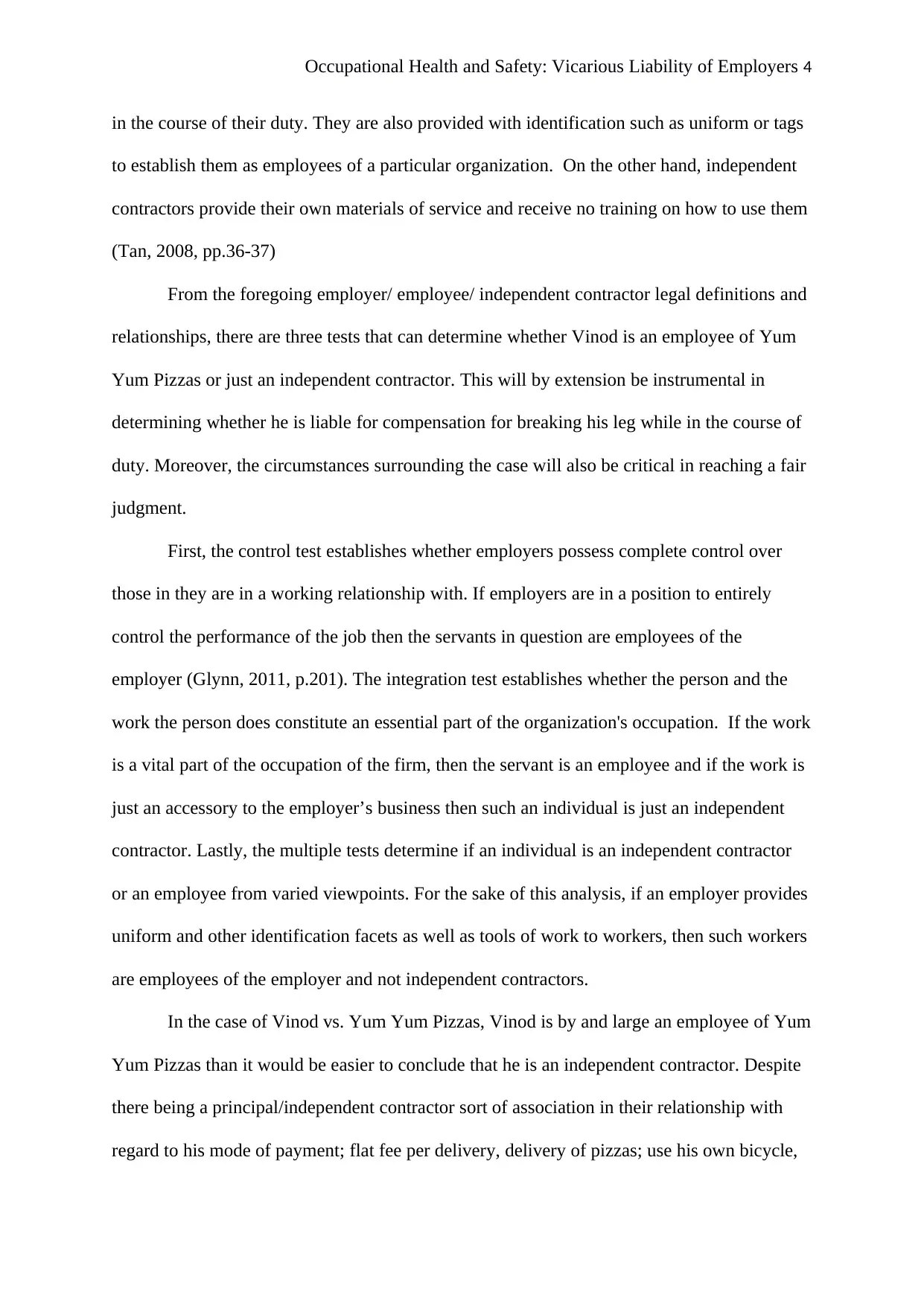
Occupational Health and Safety: Vicarious Liability of Employers 4
in the course of their duty. They are also provided with identification such as uniform or tags
to establish them as employees of a particular organization. On the other hand, independent
contractors provide their own materials of service and receive no training on how to use them
(Tan, 2008, pp.36-37)
From the foregoing employer/ employee/ independent contractor legal definitions and
relationships, there are three tests that can determine whether Vinod is an employee of Yum
Yum Pizzas or just an independent contractor. This will by extension be instrumental in
determining whether he is liable for compensation for breaking his leg while in the course of
duty. Moreover, the circumstances surrounding the case will also be critical in reaching a fair
judgment.
First, the control test establishes whether employers possess complete control over
those in they are in a working relationship with. If employers are in a position to entirely
control the performance of the job then the servants in question are employees of the
employer (Glynn, 2011, p.201). The integration test establishes whether the person and the
work the person does constitute an essential part of the organization's occupation. If the work
is a vital part of the occupation of the firm, then the servant is an employee and if the work is
just an accessory to the employer’s business then such an individual is just an independent
contractor. Lastly, the multiple tests determine if an individual is an independent contractor
or an employee from varied viewpoints. For the sake of this analysis, if an employer provides
uniform and other identification facets as well as tools of work to workers, then such workers
are employees of the employer and not independent contractors.
In the case of Vinod vs. Yum Yum Pizzas, Vinod is by and large an employee of Yum
Yum Pizzas than it would be easier to conclude that he is an independent contractor. Despite
there being a principal/independent contractor sort of association in their relationship with
regard to his mode of payment; flat fee per delivery, delivery of pizzas; use his own bicycle,
in the course of their duty. They are also provided with identification such as uniform or tags
to establish them as employees of a particular organization. On the other hand, independent
contractors provide their own materials of service and receive no training on how to use them
(Tan, 2008, pp.36-37)
From the foregoing employer/ employee/ independent contractor legal definitions and
relationships, there are three tests that can determine whether Vinod is an employee of Yum
Yum Pizzas or just an independent contractor. This will by extension be instrumental in
determining whether he is liable for compensation for breaking his leg while in the course of
duty. Moreover, the circumstances surrounding the case will also be critical in reaching a fair
judgment.
First, the control test establishes whether employers possess complete control over
those in they are in a working relationship with. If employers are in a position to entirely
control the performance of the job then the servants in question are employees of the
employer (Glynn, 2011, p.201). The integration test establishes whether the person and the
work the person does constitute an essential part of the organization's occupation. If the work
is a vital part of the occupation of the firm, then the servant is an employee and if the work is
just an accessory to the employer’s business then such an individual is just an independent
contractor. Lastly, the multiple tests determine if an individual is an independent contractor
or an employee from varied viewpoints. For the sake of this analysis, if an employer provides
uniform and other identification facets as well as tools of work to workers, then such workers
are employees of the employer and not independent contractors.
In the case of Vinod vs. Yum Yum Pizzas, Vinod is by and large an employee of Yum
Yum Pizzas than it would be easier to conclude that he is an independent contractor. Despite
there being a principal/independent contractor sort of association in their relationship with
regard to his mode of payment; flat fee per delivery, delivery of pizzas; use his own bicycle,
Paraphrase This Document
Need a fresh take? Get an instant paraphrase of this document with our AI Paraphraser
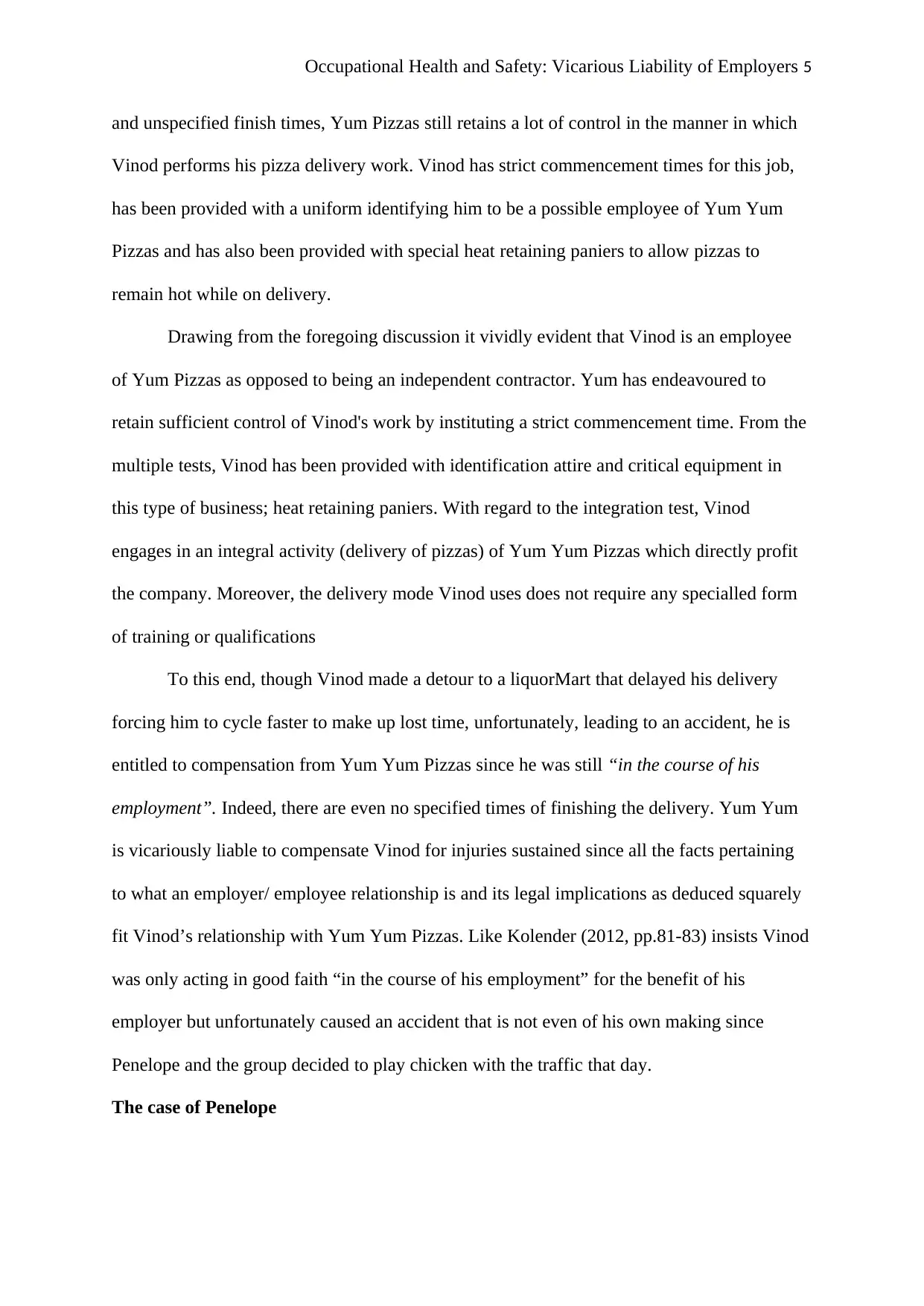
Occupational Health and Safety: Vicarious Liability of Employers 5
and unspecified finish times, Yum Pizzas still retains a lot of control in the manner in which
Vinod performs his pizza delivery work. Vinod has strict commencement times for this job,
has been provided with a uniform identifying him to be a possible employee of Yum Yum
Pizzas and has also been provided with special heat retaining paniers to allow pizzas to
remain hot while on delivery.
Drawing from the foregoing discussion it vividly evident that Vinod is an employee
of Yum Pizzas as opposed to being an independent contractor. Yum has endeavoured to
retain sufficient control of Vinod's work by instituting a strict commencement time. From the
multiple tests, Vinod has been provided with identification attire and critical equipment in
this type of business; heat retaining paniers. With regard to the integration test, Vinod
engages in an integral activity (delivery of pizzas) of Yum Yum Pizzas which directly profit
the company. Moreover, the delivery mode Vinod uses does not require any specialled form
of training or qualifications
To this end, though Vinod made a detour to a liquorMart that delayed his delivery
forcing him to cycle faster to make up lost time, unfortunately, leading to an accident, he is
entitled to compensation from Yum Yum Pizzas since he was still “in the course of his
employment”. Indeed, there are even no specified times of finishing the delivery. Yum Yum
is vicariously liable to compensate Vinod for injuries sustained since all the facts pertaining
to what an employer/ employee relationship is and its legal implications as deduced squarely
fit Vinod’s relationship with Yum Yum Pizzas. Like Kolender (2012, pp.81-83) insists Vinod
was only acting in good faith “in the course of his employment” for the benefit of his
employer but unfortunately caused an accident that is not even of his own making since
Penelope and the group decided to play chicken with the traffic that day.
The case of Penelope
and unspecified finish times, Yum Pizzas still retains a lot of control in the manner in which
Vinod performs his pizza delivery work. Vinod has strict commencement times for this job,
has been provided with a uniform identifying him to be a possible employee of Yum Yum
Pizzas and has also been provided with special heat retaining paniers to allow pizzas to
remain hot while on delivery.
Drawing from the foregoing discussion it vividly evident that Vinod is an employee
of Yum Pizzas as opposed to being an independent contractor. Yum has endeavoured to
retain sufficient control of Vinod's work by instituting a strict commencement time. From the
multiple tests, Vinod has been provided with identification attire and critical equipment in
this type of business; heat retaining paniers. With regard to the integration test, Vinod
engages in an integral activity (delivery of pizzas) of Yum Yum Pizzas which directly profit
the company. Moreover, the delivery mode Vinod uses does not require any specialled form
of training or qualifications
To this end, though Vinod made a detour to a liquorMart that delayed his delivery
forcing him to cycle faster to make up lost time, unfortunately, leading to an accident, he is
entitled to compensation from Yum Yum Pizzas since he was still “in the course of his
employment”. Indeed, there are even no specified times of finishing the delivery. Yum Yum
is vicariously liable to compensate Vinod for injuries sustained since all the facts pertaining
to what an employer/ employee relationship is and its legal implications as deduced squarely
fit Vinod’s relationship with Yum Yum Pizzas. Like Kolender (2012, pp.81-83) insists Vinod
was only acting in good faith “in the course of his employment” for the benefit of his
employer but unfortunately caused an accident that is not even of his own making since
Penelope and the group decided to play chicken with the traffic that day.
The case of Penelope
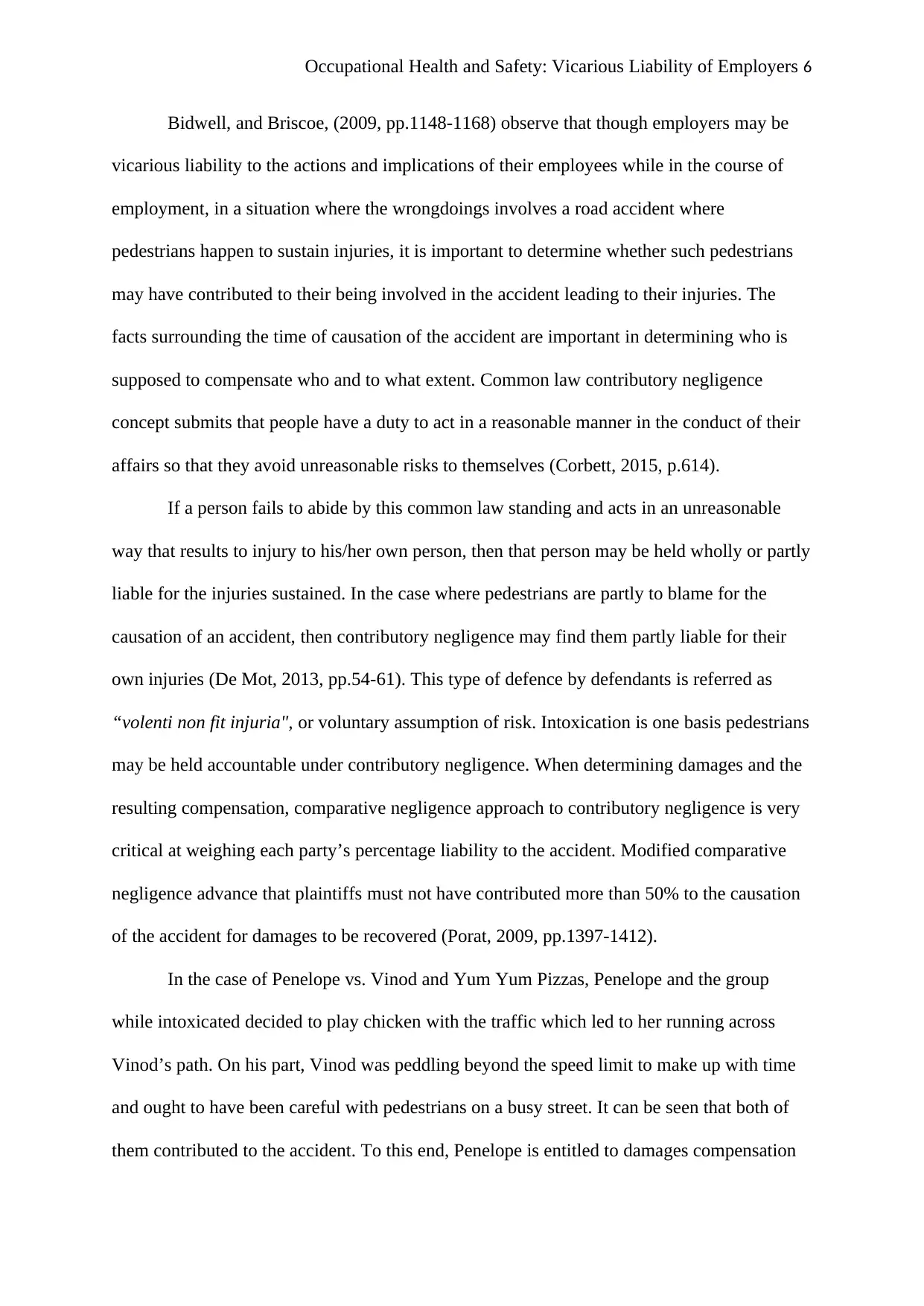
Occupational Health and Safety: Vicarious Liability of Employers 6
Bidwell, and Briscoe, (2009, pp.1148-1168) observe that though employers may be
vicarious liability to the actions and implications of their employees while in the course of
employment, in a situation where the wrongdoings involves a road accident where
pedestrians happen to sustain injuries, it is important to determine whether such pedestrians
may have contributed to their being involved in the accident leading to their injuries. The
facts surrounding the time of causation of the accident are important in determining who is
supposed to compensate who and to what extent. Common law contributory negligence
concept submits that people have a duty to act in a reasonable manner in the conduct of their
affairs so that they avoid unreasonable risks to themselves (Corbett, 2015, p.614).
If a person fails to abide by this common law standing and acts in an unreasonable
way that results to injury to his/her own person, then that person may be held wholly or partly
liable for the injuries sustained. In the case where pedestrians are partly to blame for the
causation of an accident, then contributory negligence may find them partly liable for their
own injuries (De Mot, 2013, pp.54-61). This type of defence by defendants is referred as
“volenti non fit injuria", or voluntary assumption of risk. Intoxication is one basis pedestrians
may be held accountable under contributory negligence. When determining damages and the
resulting compensation, comparative negligence approach to contributory negligence is very
critical at weighing each party’s percentage liability to the accident. Modified comparative
negligence advance that plaintiffs must not have contributed more than 50% to the causation
of the accident for damages to be recovered (Porat, 2009, pp.1397-1412).
In the case of Penelope vs. Vinod and Yum Yum Pizzas, Penelope and the group
while intoxicated decided to play chicken with the traffic which led to her running across
Vinod’s path. On his part, Vinod was peddling beyond the speed limit to make up with time
and ought to have been careful with pedestrians on a busy street. It can be seen that both of
them contributed to the accident. To this end, Penelope is entitled to damages compensation
Bidwell, and Briscoe, (2009, pp.1148-1168) observe that though employers may be
vicarious liability to the actions and implications of their employees while in the course of
employment, in a situation where the wrongdoings involves a road accident where
pedestrians happen to sustain injuries, it is important to determine whether such pedestrians
may have contributed to their being involved in the accident leading to their injuries. The
facts surrounding the time of causation of the accident are important in determining who is
supposed to compensate who and to what extent. Common law contributory negligence
concept submits that people have a duty to act in a reasonable manner in the conduct of their
affairs so that they avoid unreasonable risks to themselves (Corbett, 2015, p.614).
If a person fails to abide by this common law standing and acts in an unreasonable
way that results to injury to his/her own person, then that person may be held wholly or partly
liable for the injuries sustained. In the case where pedestrians are partly to blame for the
causation of an accident, then contributory negligence may find them partly liable for their
own injuries (De Mot, 2013, pp.54-61). This type of defence by defendants is referred as
“volenti non fit injuria", or voluntary assumption of risk. Intoxication is one basis pedestrians
may be held accountable under contributory negligence. When determining damages and the
resulting compensation, comparative negligence approach to contributory negligence is very
critical at weighing each party’s percentage liability to the accident. Modified comparative
negligence advance that plaintiffs must not have contributed more than 50% to the causation
of the accident for damages to be recovered (Porat, 2009, pp.1397-1412).
In the case of Penelope vs. Vinod and Yum Yum Pizzas, Penelope and the group
while intoxicated decided to play chicken with the traffic which led to her running across
Vinod’s path. On his part, Vinod was peddling beyond the speed limit to make up with time
and ought to have been careful with pedestrians on a busy street. It can be seen that both of
them contributed to the accident. To this end, Penelope is entitled to damages compensation
⊘ This is a preview!⊘
Do you want full access?
Subscribe today to unlock all pages.

Trusted by 1+ million students worldwide
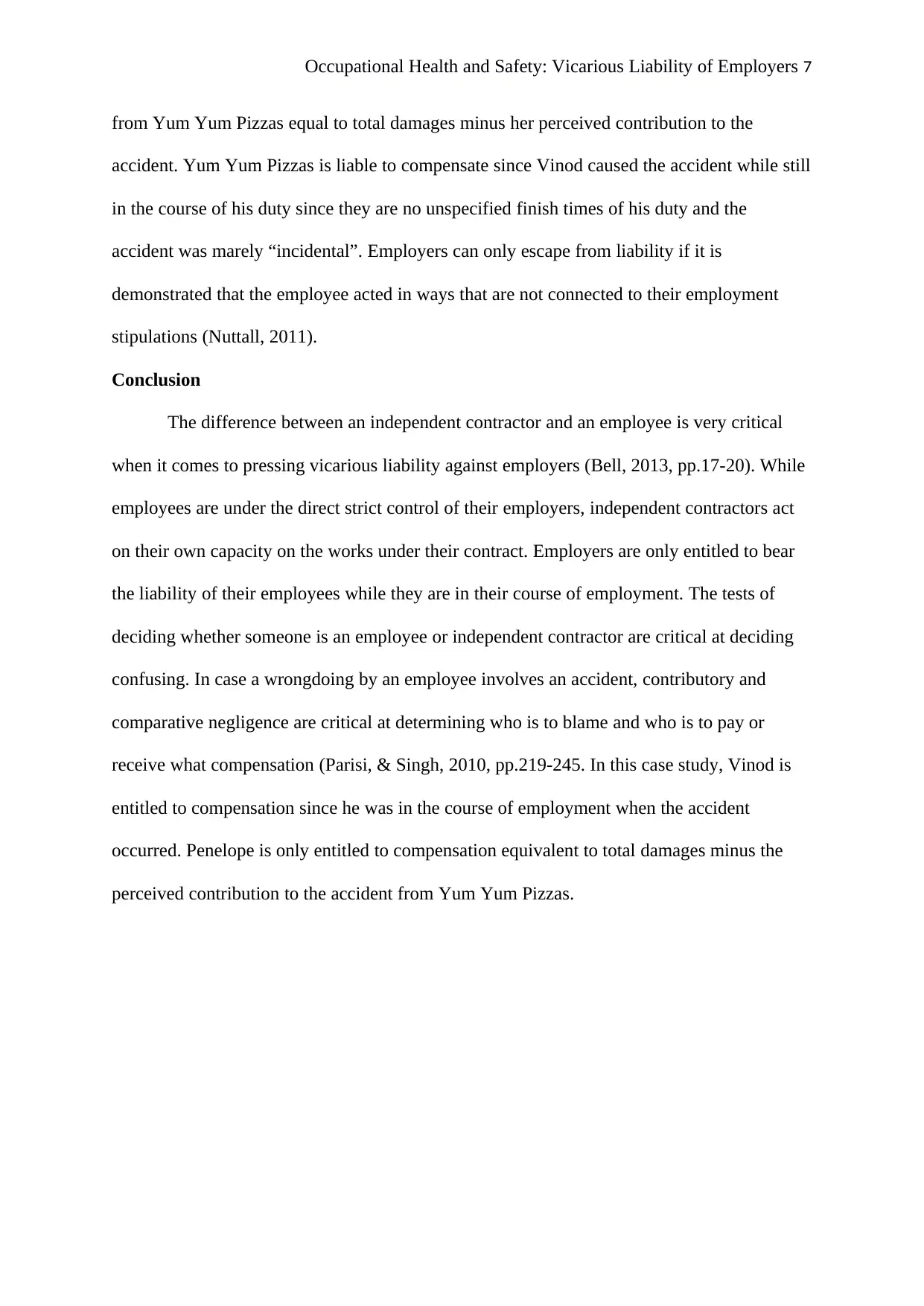
Occupational Health and Safety: Vicarious Liability of Employers 7
from Yum Yum Pizzas equal to total damages minus her perceived contribution to the
accident. Yum Yum Pizzas is liable to compensate since Vinod caused the accident while still
in the course of his duty since they are no unspecified finish times of his duty and the
accident was marely “incidental”. Employers can only escape from liability if it is
demonstrated that the employee acted in ways that are not connected to their employment
stipulations (Nuttall, 2011).
Conclusion
The difference between an independent contractor and an employee is very critical
when it comes to pressing vicarious liability against employers (Bell, 2013, pp.17-20). While
employees are under the direct strict control of their employers, independent contractors act
on their own capacity on the works under their contract. Employers are only entitled to bear
the liability of their employees while they are in their course of employment. The tests of
deciding whether someone is an employee or independent contractor are critical at deciding
confusing. In case a wrongdoing by an employee involves an accident, contributory and
comparative negligence are critical at determining who is to blame and who is to pay or
receive what compensation (Parisi, & Singh, 2010, pp.219-245. In this case study, Vinod is
entitled to compensation since he was in the course of employment when the accident
occurred. Penelope is only entitled to compensation equivalent to total damages minus the
perceived contribution to the accident from Yum Yum Pizzas.
from Yum Yum Pizzas equal to total damages minus her perceived contribution to the
accident. Yum Yum Pizzas is liable to compensate since Vinod caused the accident while still
in the course of his duty since they are no unspecified finish times of his duty and the
accident was marely “incidental”. Employers can only escape from liability if it is
demonstrated that the employee acted in ways that are not connected to their employment
stipulations (Nuttall, 2011).
Conclusion
The difference between an independent contractor and an employee is very critical
when it comes to pressing vicarious liability against employers (Bell, 2013, pp.17-20). While
employees are under the direct strict control of their employers, independent contractors act
on their own capacity on the works under their contract. Employers are only entitled to bear
the liability of their employees while they are in their course of employment. The tests of
deciding whether someone is an employee or independent contractor are critical at deciding
confusing. In case a wrongdoing by an employee involves an accident, contributory and
comparative negligence are critical at determining who is to blame and who is to pay or
receive what compensation (Parisi, & Singh, 2010, pp.219-245. In this case study, Vinod is
entitled to compensation since he was in the course of employment when the accident
occurred. Penelope is only entitled to compensation equivalent to total damages minus the
perceived contribution to the accident from Yum Yum Pizzas.
Paraphrase This Document
Need a fresh take? Get an instant paraphrase of this document with our AI Paraphraser
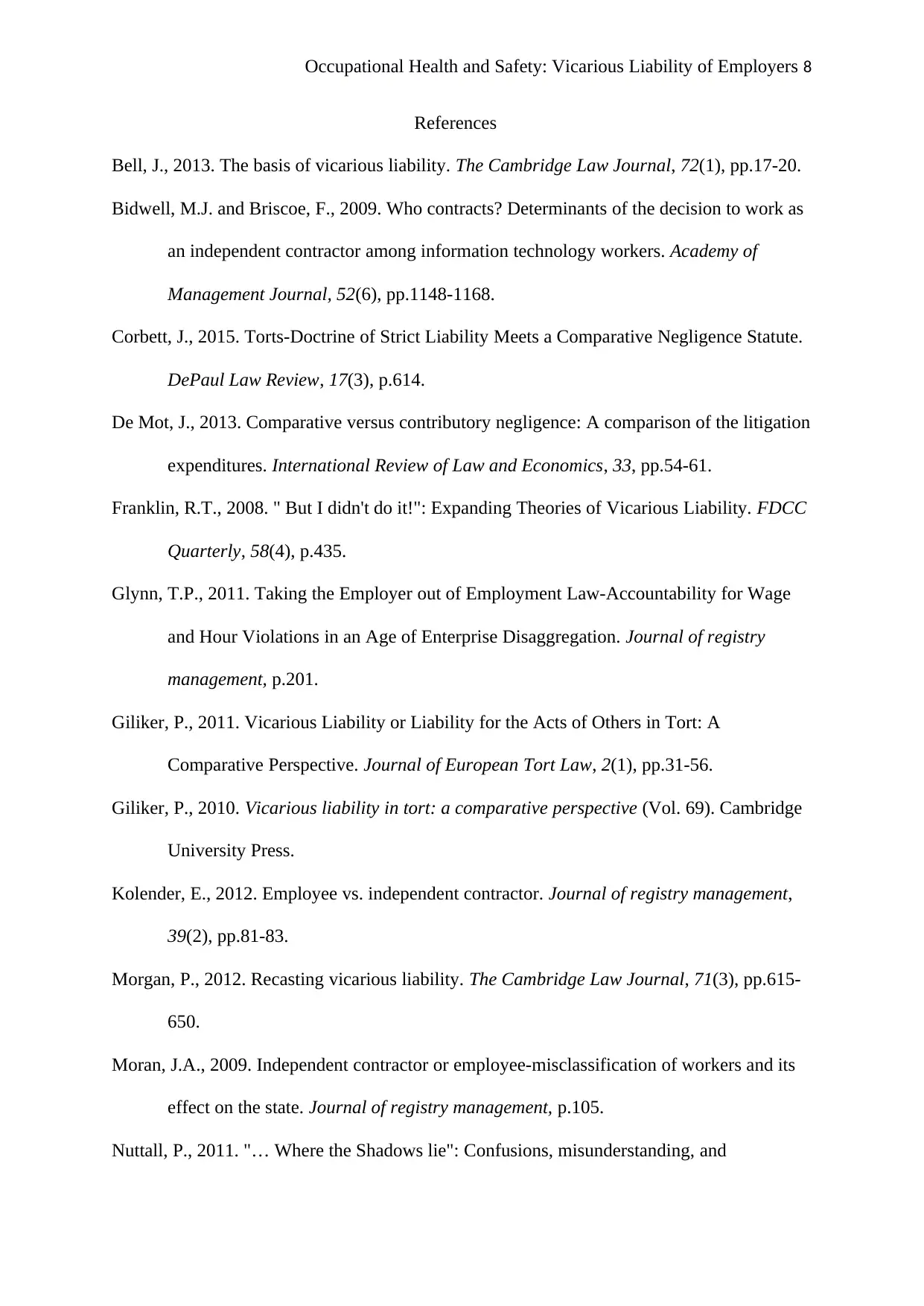
Occupational Health and Safety: Vicarious Liability of Employers 8
References
Bell, J., 2013. The basis of vicarious liability. The Cambridge Law Journal, 72(1), pp.17-20.
Bidwell, M.J. and Briscoe, F., 2009. Who contracts? Determinants of the decision to work as
an independent contractor among information technology workers. Academy of
Management Journal, 52(6), pp.1148-1168.
Corbett, J., 2015. Torts-Doctrine of Strict Liability Meets a Comparative Negligence Statute.
DePaul Law Review, 17(3), p.614.
De Mot, J., 2013. Comparative versus contributory negligence: A comparison of the litigation
expenditures. International Review of Law and Economics, 33, pp.54-61.
Franklin, R.T., 2008. " But I didn't do it!": Expanding Theories of Vicarious Liability. FDCC
Quarterly, 58(4), p.435.
Glynn, T.P., 2011. Taking the Employer out of Employment Law-Accountability for Wage
and Hour Violations in an Age of Enterprise Disaggregation. Journal of registry
management, p.201.
Giliker, P., 2011. Vicarious Liability or Liability for the Acts of Others in Tort: A
Comparative Perspective. Journal of European Tort Law, 2(1), pp.31-56.
Giliker, P., 2010. Vicarious liability in tort: a comparative perspective (Vol. 69). Cambridge
University Press.
Kolender, E., 2012. Employee vs. independent contractor. Journal of registry management,
39(2), pp.81-83.
Morgan, P., 2012. Recasting vicarious liability. The Cambridge Law Journal, 71(3), pp.615-
650.
Moran, J.A., 2009. Independent contractor or employee-misclassification of workers and its
effect on the state. Journal of registry management, p.105.
Nuttall, P., 2011. "… Where the Shadows lie": Confusions, misunderstanding, and
References
Bell, J., 2013. The basis of vicarious liability. The Cambridge Law Journal, 72(1), pp.17-20.
Bidwell, M.J. and Briscoe, F., 2009. Who contracts? Determinants of the decision to work as
an independent contractor among information technology workers. Academy of
Management Journal, 52(6), pp.1148-1168.
Corbett, J., 2015. Torts-Doctrine of Strict Liability Meets a Comparative Negligence Statute.
DePaul Law Review, 17(3), p.614.
De Mot, J., 2013. Comparative versus contributory negligence: A comparison of the litigation
expenditures. International Review of Law and Economics, 33, pp.54-61.
Franklin, R.T., 2008. " But I didn't do it!": Expanding Theories of Vicarious Liability. FDCC
Quarterly, 58(4), p.435.
Glynn, T.P., 2011. Taking the Employer out of Employment Law-Accountability for Wage
and Hour Violations in an Age of Enterprise Disaggregation. Journal of registry
management, p.201.
Giliker, P., 2011. Vicarious Liability or Liability for the Acts of Others in Tort: A
Comparative Perspective. Journal of European Tort Law, 2(1), pp.31-56.
Giliker, P., 2010. Vicarious liability in tort: a comparative perspective (Vol. 69). Cambridge
University Press.
Kolender, E., 2012. Employee vs. independent contractor. Journal of registry management,
39(2), pp.81-83.
Morgan, P., 2012. Recasting vicarious liability. The Cambridge Law Journal, 71(3), pp.615-
650.
Moran, J.A., 2009. Independent contractor or employee-misclassification of workers and its
effect on the state. Journal of registry management, p.105.
Nuttall, P., 2011. "… Where the Shadows lie": Confusions, misunderstanding, and
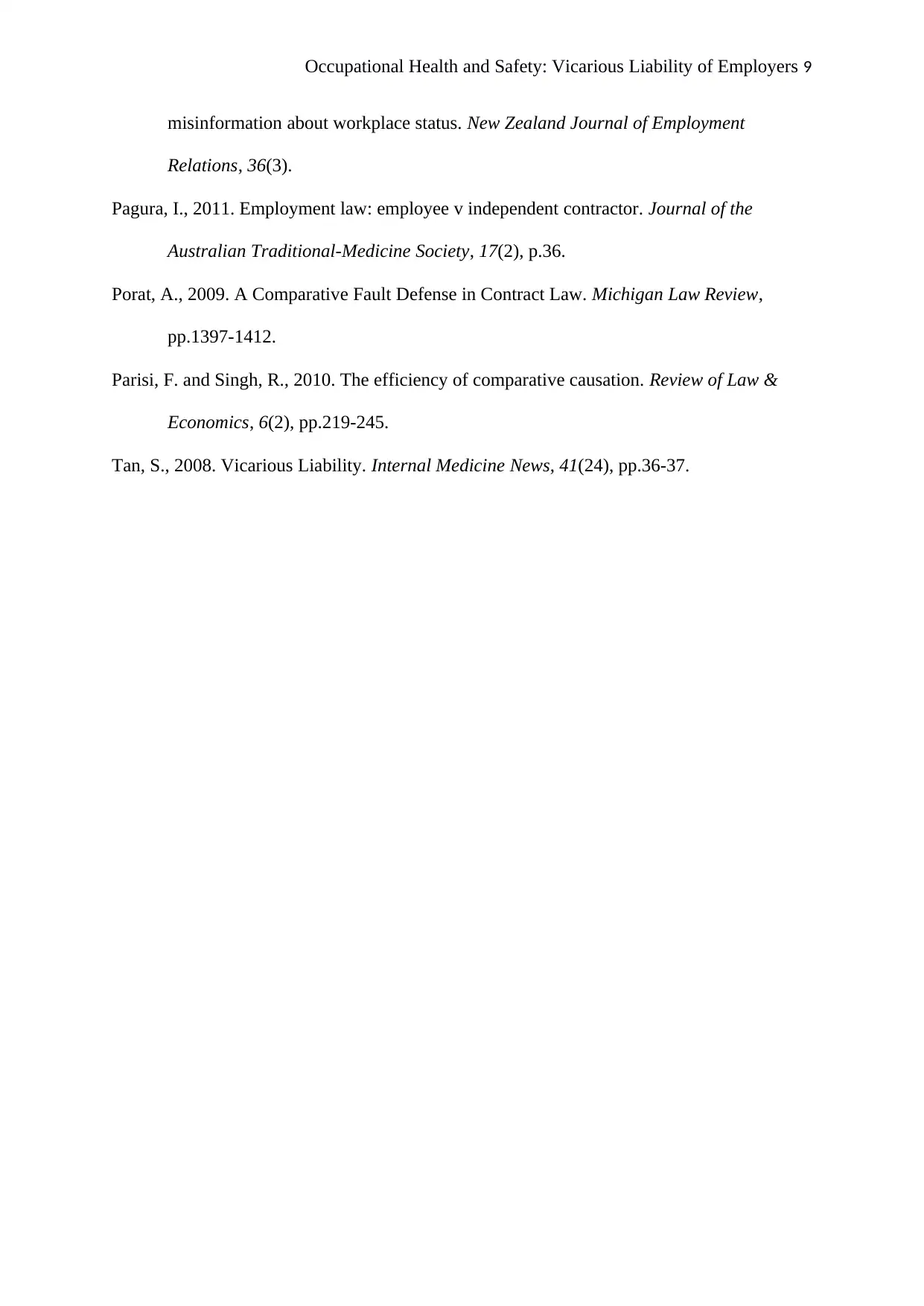
Occupational Health and Safety: Vicarious Liability of Employers 9
misinformation about workplace status. New Zealand Journal of Employment
Relations, 36(3).
Pagura, I., 2011. Employment law: employee v independent contractor. Journal of the
Australian Traditional-Medicine Society, 17(2), p.36.
Porat, A., 2009. A Comparative Fault Defense in Contract Law. Michigan Law Review,
pp.1397-1412.
Parisi, F. and Singh, R., 2010. The efficiency of comparative causation. Review of Law &
Economics, 6(2), pp.219-245.
Tan, S., 2008. Vicarious Liability. Internal Medicine News, 41(24), pp.36-37.
misinformation about workplace status. New Zealand Journal of Employment
Relations, 36(3).
Pagura, I., 2011. Employment law: employee v independent contractor. Journal of the
Australian Traditional-Medicine Society, 17(2), p.36.
Porat, A., 2009. A Comparative Fault Defense in Contract Law. Michigan Law Review,
pp.1397-1412.
Parisi, F. and Singh, R., 2010. The efficiency of comparative causation. Review of Law &
Economics, 6(2), pp.219-245.
Tan, S., 2008. Vicarious Liability. Internal Medicine News, 41(24), pp.36-37.
⊘ This is a preview!⊘
Do you want full access?
Subscribe today to unlock all pages.

Trusted by 1+ million students worldwide
1 out of 9
Related Documents
Your All-in-One AI-Powered Toolkit for Academic Success.
+13062052269
info@desklib.com
Available 24*7 on WhatsApp / Email
![[object Object]](/_next/static/media/star-bottom.7253800d.svg)
Unlock your academic potential
Copyright © 2020–2025 A2Z Services. All Rights Reserved. Developed and managed by ZUCOL.




